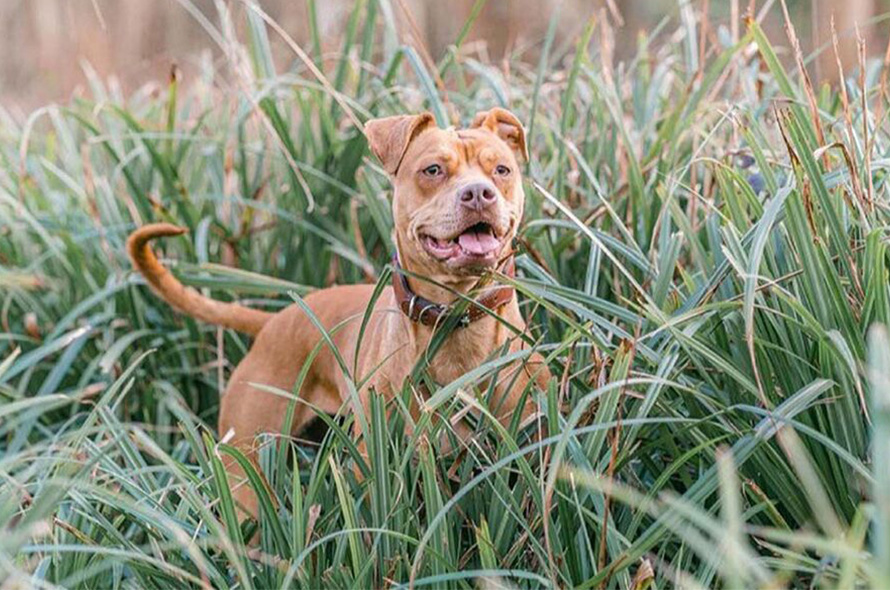Dogs often like to explore their surroundings with their nose and mouth, so it is important to know which plants may be harmful to them. If you don’t know the name of a plant in your garden, check out this guide from the Royal Horticultural Society. You can find our tips on creating a dog friendly garden.

Please note, this is not a full list of all poisonous plants in the UK. If you are unsure, always contact your vet, and consider keeping your dog on a lead around any unknown plants before you've had chance to identify them.
Alliums
Alliums are a family of flowering plants, including onions, garlic, shallots, leeks, and chives. They are often grown as crops but can also be found as flowering plants in gardens. If your dog eats any part of the plant, they may be at risk of anemia, which can become fatal for dogs.
Azaleas and Rhododendrons
Azaleas and rhododendrons are a family of shrub that blossom in spring. They contain a powerful neurotoxin which can disturb the body’s cell membranes. Eating these plants can cause vomiting and difficulty breathing and may be fatal.
Bergenia
Also known as Elephant Ear, Bergenia can be fatal in any quantity. Symptoms include irritation, difficulty breathing and swelling of the tongue, which can lead to suffocation if you do not act fast.
Bleeding Heart (Dicentra Formosa)
The bleeding-heart plant contains isoquinoline alkaloids which cause vomiting, as well as convulsants that can cause seizures. Eating large amounts of this plant can make your dog very unwell.
Delphinium
Delphinium is a tall flowering plant that can cause symptoms from constipation to heart failure. The alkaloids in the plant can block receptors in your dog’s muscles and can be fatal.
Foxgloves
Foxgloves are a flowering plant found in woodlands and gardens and can be fatal if consumed by dogs. All parts of the plant contain cardiac glycosides, which can cause severe heart problems if eaten.
Hellebores
A member of the buttercup family, hellebores are toxic to animals. While its unpleasant taste often stops dogs from eating it, puppies may eat without tasting. Symptoms include vomiting and diarrhoea, drooling and lethargy.
Lilies
This family of flowering plant includes lily of the valley, calla lily and peace lily varieties, all of which are potentially toxic for dogs. The pollen, bulb and foliage of these plants can cause a variety of symptoms depending on the variety of lily, but the most common symptoms are vomiting, diarrhoea, lack of appetite and drooling.
Mistletoe
This weed, which can be found growing at the tops of trees, is often used as decoration around Christmas time. Mistletoe berries can be fatal, especially to small dogs and puppies. The symptoms include vomiting, diarrhoea, and collapse.
Nicotiana (Tobacco Flower)
This floral plant contains alkaloids which are toxic to pets. These toxins cause complex symptoms affecting the central nervous system.
Oleander
Oleanders are flowering plants that can grow into large trees/hedges. The foliage contains cardiac glycosides which affect the heart, the bark is very toxic, and even a small amount of this plant can be fatal if eaten.
Perennial Bulbs
Spring often means bulb planting season, but many common bulbs are actually toxic to dogs. Daffodils, tulips, narcissus, and bluebell bulbs can all make your pet unwell if eaten, with symptoms including vomiting, diarrhoea, and irritation in your pet’s mouth.
Ragwort
Senecio varieties, including ragwort and angel wings, are common weeds which can cause kidney damage and liver failure if eaten. Symptoms include lethargy and gastrointestinal issues which may begin straight away or develop over a few days.
Sacred Bamboo
This outdoor shrub with white flowers and red berries, is very toxic to pets. The plant contains toxins which can cause difficulty breathing, vomiting and collapse, and should be treated very seriously.
Spurge
Euphorbiaceae plants, such as pencil cactus and spurge, are all toxic to animals. If ingested, symptoms include vomiting and diarrhoea, while the sap from plants can cause skin irritation and blindness.
Wisteria
Wisteria is a climbing vine with recognisable bunches of pink or purple flowers. The plant, especially the seed pods, contain lectin and wisterin toxins which can be fatal if consumed. As there are often no immediate symptoms when eaten, your dog may continue eating, so it is important to get to a vet as soon as you can.
Yew
The needles and cones of these evergreen trees are extremely poisonous to dogs. Any part of the tree can be toxic if eaten, causing dizziness, drooling, vomiting and diarrhoea.
What should I do if my dog has eaten any of these?
If consumed, even small amounts of these plants can be fatal so always act immediately and take your dog to the vets.



